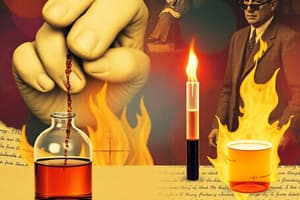Podcast
Questions and Answers
Which of the following statements accurately describes the relationship between enthalpy change (ΔH) and the type of reaction occurring at constant pressure?
Which of the following statements accurately describes the relationship between enthalpy change (ΔH) and the type of reaction occurring at constant pressure?
- ΔH = 0 indicates an endothermic reaction, where heat is absorbed.
- ΔH < 0 indicates an exothermic reaction, where heat is released. (correct)
- ΔH > 0 indicates an exothermic reaction, where heat is released.
- ΔH < 0 indicates an endothermic reaction, where heat is absorbed.
For an isolated system, which statement accurately reflects the implications of the Second Law of Thermodynamics?
For an isolated system, which statement accurately reflects the implications of the Second Law of Thermodynamics?
- The entropy of the system tends to decrease over time.
- The entropy of the system remains constant.
- The entropy of the system tends to increase over time. (correct)
- The entropy of the system is always zero.
What is the key criterion for a process to be considered spontaneous at constant temperature and pressure, based on Gibbs Free Energy (ΔG)?
What is the key criterion for a process to be considered spontaneous at constant temperature and pressure, based on Gibbs Free Energy (ΔG)?
- ΔG > 0
- ΔG = 0
- ΔG = ΔH - TΔS = 0
- ΔG < 0 (correct)
Which of the following accurately defines Chemical Potential (μ)?
Which of the following accurately defines Chemical Potential (μ)?
In the context of phase equilibria, what does the Gibbs Phase Rule (F = C - P + 2) allow us to determine?
In the context of phase equilibria, what does the Gibbs Phase Rule (F = C - P + 2) allow us to determine?
What condition defines chemical equilibrium in a reversible reaction?
What condition defines chemical equilibrium in a reversible reaction?
For the reaction aA + bB ⇌ cC + dD, how is the equilibrium constant (K) expressed in terms of the concentrations of reactants and products?
For the reaction aA + bB ⇌ cC + dD, how is the equilibrium constant (K) expressed in terms of the concentrations of reactants and products?
According to Le Chatelier's Principle, how will a system at equilibrium respond to an increase in temperature?
According to Le Chatelier's Principle, how will a system at equilibrium respond to an increase in temperature?
Which of the following is an example of an extensive property?
Which of the following is an example of an extensive property?
A scientist performs a reaction in a closed container, and observes that the temperature of the water bath surrounding the container decreases during the reaction. What can be concluded about the reaction?
A scientist performs a reaction in a closed container, and observes that the temperature of the water bath surrounding the container decreases during the reaction. What can be concluded about the reaction?
Flashcards
Chemical Thermodynamics
Chemical Thermodynamics
Study of heat/work related to chemical reactions or physical changes under thermodynamic laws.
System (Thermodynamics)
System (Thermodynamics)
Part of the universe under investigation.
Open System
Open System
Exchanges both matter and energy with surroundings.
Closed System
Closed System
Signup and view all the flashcards
Isolated System
Isolated System
Signup and view all the flashcards
State Variables
State Variables
Signup and view all the flashcards
First Law of Thermodynamics
First Law of Thermodynamics
Signup and view all the flashcards
First Law of Thermodynamics: Definition.
First Law of Thermodynamics: Definition.
Signup and view all the flashcards
Entropy (S)
Entropy (S)
Signup and view all the flashcards
Second Law of Thermodynamics
Second Law of Thermodynamics
Signup and view all the flashcards
Study Notes
- Chemistry is the study of matter, its properties, and how matter changes.
- Physical chemistry studies macroscopic and particulate phenomena in chemical systems using principles and concepts from physics.
- Includes motion, energy, force, time, thermodynamics, quantum chemistry, statistical mechanics, analytical dynamics, and chemical equilibria.
Chemical Thermodynamics
- The study of the interrelation of heat and work with chemical reactions or physical changes of state.
- Involves applying thermodynamic principles to chemical systems and reactions.
- Predicts the feasibility and equilibrium composition of chemical reactions.
- Key concepts: energy, entropy, Gibbs free energy, and chemical potential.
- Focuses on the bulk properties of matter, not microscopic details.
Basic Concepts in Thermodynamics
- System: The part of the universe under investigation.
- Surroundings: Everything outside the system.
- Boundary: Separates the system from the surroundings.
- Types of systems:
- Open system: Exchanges both matter and energy with the surroundings.
- Closed system: Exchanges energy but not matter with the surroundings.
- Isolated system: Exchanges neither matter nor energy with the surroundings.
- State variables: Properties defining the state of a system like pressure, volume, temperature, and composition.
- State functions: Properties depending only on the initial and final states of the system, such as internal energy, enthalpy, entropy, and Gibbs free energy.
- Intensive properties: Independent of the amount of substance, examples include temperature, pressure, and density.
- Extensive properties: Dependent on the amount of substance, examples include volume, mass, and energy.
Laws of Thermodynamics
- Zeroth Law: If two systems are each in thermal equilibrium with a third system, then they are in thermal equilibrium with each other.
- First Law: The total energy of an isolated system is constant; energy can be transformed, but not created or destroyed.
- ΔU = Q - W, where ΔU is the change in internal energy, Q is the heat added to the system, and W is the work done by the system.
- Second Law: The entropy of an isolated system tends to increase.
- Entropy (S) measures the disorder or randomness of a system.
- ΔS ≥ 0 for an isolated system.
- Third Law: The entropy of a perfect crystal at absolute zero (0 K) is zero.
- Provides a reference point for determining the absolute entropy of a substance at any other temperature.
Enthalpy (H)
- A thermodynamic property of a system, defined as the sum of the system's internal energy (U) and the product of its pressure (P) and volume (V).
- H = U + PV
- A state function, so the change in enthalpy (ΔH) depends only on the initial and final states.
- ΔH = ΔU + PΔV (at constant pressure)
- In chemical reactions, enthalpy change (ΔH) represents the heat absorbed or released during the reaction at constant pressure.
- Exothermic reaction: ΔH < 0 (heat is released).
- Endothermic reaction: ΔH > 0 (heat is absorbed).
- Standard enthalpy of formation (ΔHf°): The enthalpy change when one mole of a compound is formed from its elements in their standard states (usually 298 K and 1 atm).
Entropy (S)
- Measures the disorder or randomness of a system.
- A state function.
- The change in entropy (ΔS) is related to the heat absorbed or released (Q) and the temperature (T) by the equation: ΔS = Qrev/T, where Qrev is the heat exchanged in a reversible process.
- Entropy increases with increasing temperature, volume, and number of particles.
- A key factor in determining the spontaneity of a process.
- Standard entropy (S°): The absolute entropy of a substance at 298 K and 1 atm.
Gibbs Free Energy (G)
- A thermodynamic potential that measures the amount of energy available in a thermodynamic system to do useful work at constant temperature and pressure.
- G = H - TS, where H is enthalpy, T is temperature, and S is entropy.
- A state function.
- The change in Gibbs free energy (ΔG) is a criterion for spontaneity at constant temperature and pressure.
- ΔG < 0: The process is spontaneous ( Gibbs free energy decreases).
- ΔG > 0: The process is non-spontaneous ( Gibbs free energy increases).
- ΔG = 0: The process is at equilibrium ( Gibbs free energy is at a minimum).
- ΔG = ΔH - TΔS
- Standard Gibbs free energy change (ΔG°): The change in Gibbs free energy when a reaction is carried out under standard conditions (usually 298 K and 1 atm).
Chemical Potential (μ)
- The change in the Gibbs free energy of a system when one mole of a substance is added to the system at constant temperature and pressure.
- Indicates how the Gibbs free energy of a system changes with variations in the number of moles of a particular component.
- An intensive property.
- For a pure substance, the chemical potential is equal to the molar Gibbs free energy.
- Crucial in determining phase equilibria and chemical equilibria.
Phase Equilibria
- Deals with the conditions under which two or more phases of a substance can coexist in equilibrium.
- Phase: A homogeneous part of a system that is uniform in chemical composition and physical properties.
- Phase transitions: Processes such as melting, boiling, sublimation, and phase transformations between solid forms.
- Gibbs Phase Rule: F = C - P + 2
- F is the number of degrees of freedom.
- The number of independent variables that can be changed without altering the number of phases in equilibrium.
- C is the number of components.
- The minimum number of independent chemical species necessary to define the composition of all phases in the system.
- P is the number of phases in equilibrium.
- F is the number of degrees of freedom.
Chemical Equilibria
- The state in which the rates of the forward and reverse reactions are equal.
- The net change in concentrations of reactants and products is zero.
- Equilibrium constant (K): A quantitative measure of the extent to which a reaction will proceed to completion.
- For a reversible reaction: aA + bB ⇌ cC + dD
- The equilibrium constant is expressed as: K = ([C]^c [D]^d) / ([A]^a [B]^b), where [A], [B], [C], and [D] are the equilibrium concentrations of the reactants and products.
- ΔG° = -RTlnK, where R is the gas constant and T is the temperature in Kelvin.
- Le Chatelier's Principle: If a change of condition is applied to a system in equilibrium, the system will shift in a direction that relieves the stress.
- Changes in conditions include changes in concentration, pressure, temperature, or the addition of an inert gas.
Applications of Chemical Thermodynamics
- Predicting the spontaneity of chemical reactions.
- Determining the equilibrium composition of reaction mixtures.
- Calculating the heat and work associated with chemical or physical transformations.
- Understanding phase equilibria and phase transitions.
- Optimizing industrial chemical processes to maximize yield and minimize energy consumption.
- Studying the thermodynamics of solutions and mixtures.
- Analyzing electrochemical cells and batteries.
Studying That Suits You
Use AI to generate personalized quizzes and flashcards to suit your learning preferences.




